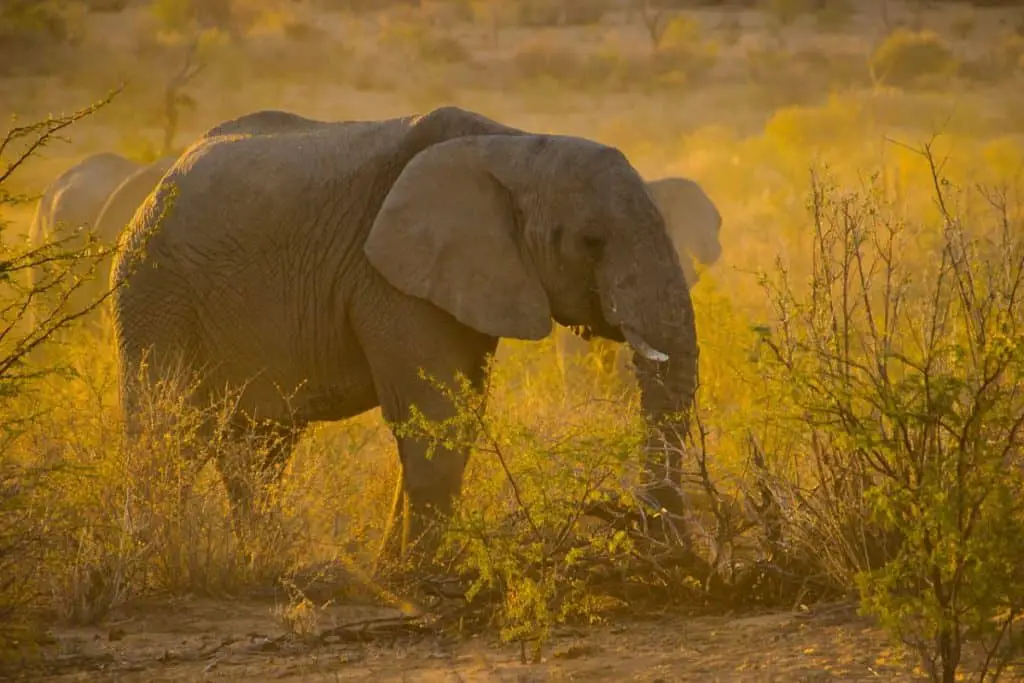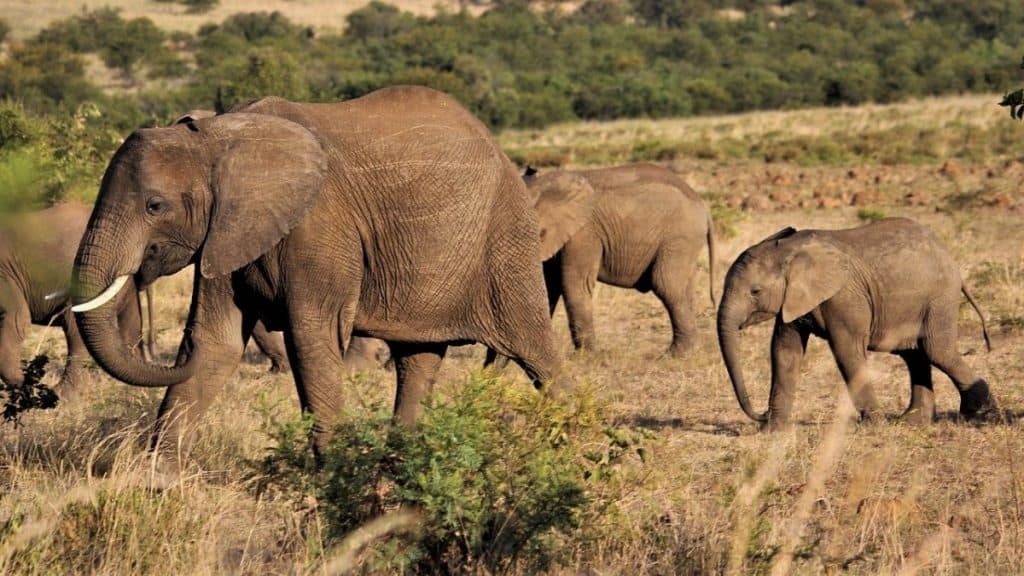African elephants are herbivores or plant-eaters. There are over 80 plants and trees that elephants will eat and many types of grasses. Elephants are browsers as they eat vegetation that grows above the ground.
Elephants eat over 80 types of plants, including the bark, leaves, roots, branches, and thorns. Elephants will feed on fruits, including figs, raisins, and marula. An adult male can eat up to 300 kg per day.
Elephants will eat almost all of some plants and trees, including the bark, leaves, roots, branches, and thorns. Elephants are sometimes thought to be quite destructive as they will destroy many trees and plants, even pushing over trees to get to the leaves.
Elephants use their trunks in lots of different ways. Find out more in this article I wrote

How much do elephants eat?
Because plants don’t contain many nutrients, an elephant has to eat a lot of food to get what it needs. An adult male needs to eat between 100 and 300 kg during an average day and between 100 and 220 litres of water. Because of the amount of time it takes to eat this much food, elephants can eat between sixteen and eighteen hours a day.
Elephants usually eat three times during the day. They typically start with a long, large meal in the morning and again in the evening and night. During the day, they try to stay out of the midday heat. Elephants do not feed in the same area for more than two days.
Elephants can be a nuisance in many areas where they feed on cultivated crops such as sugar cane, bananas, and rice.
The season affects the types of plants that elephants eat. In the wet seasons, they consume more significant amounts of grass, while in the dry season, they eat woody, herbaceous food, eating more twigs, branches, and bark.
Elephants are essential to the habitat as they are excellent seed dispersers. Because they eat many seeds, their dung spreads these out over large distances. Some plants germinate better when passed through the elephant’s digestive system, such as acacias. This is due to the hard outer coat of the shells being broken down by enzymes.
When feeding on grasses, elephants will use their trunk to grab the stems, which are then pulled up and pushed into the mouth. If the grass is too short, they will sweep it into a pile using the front feet before feeding it into its mouth.
When feeding on small shrubs, elephants use the end of their trunk. They break off twigs and branches to feed on. The elephant will put the branch into its mouth to remove bark from larger branches. Using its trunk, it will rotate the branch against the teeth or tusk to strip the bark.
There are five ways that elephants communicate. Find out what they are here
Which plants do elephants eat?
Elephants will eat vast amounts of flowers and fruits when available, and after the first rains of the season, they will dig for roots. Asian elephants eat similar food to African elephants but consume large quantities of bamboo.
The acacia tree is one of the elephant’s favourite foods, and they will eat almost every part of it. The acacia tree is a tall, shady tree, flat on top with thorny branches and a long trunk. They have small pods and white, orange, and yellow flowers.
The gardenia tree has a small tennis-ball sized fruit, dark leaves, and white or yellow flavours.
Another tree that the elephant likes to eat is the baobab tree. These have a very thick trunk and long, widespread branches. The baobab grows up to 25 meters, and elephants like them because of the high moisture content in the pith and bark. They have white flowers and a fruit that is like a gourd.
Elephants eat many types of fruit, and fruit from the marula tree can attract elephants from a long distance. The fruit is high in vitamin C and is prized by elephants, baboons, and monkeys. Elephants will sometimes ring-bark the tree, unfortunately leading to the tree’s death.
It has long been a myth that elephants would get drunk from the rotting fruit of the marula tree, but they prefer the fresh fruit from the tree. Many other animals eat the fallen fruit, and it has been calculated that an elephant would need to eat about 1,400 of this fruit to begin getting drunk.
Do you know how elephants mate? Find out here
The false thorn tree grows up to 18 meters and resembles an acacia tee. Elephants feed on the leaves along with antelope. Due to their softwood, an elephant can eat most of the tree.
The mopane tree feeds not only one of the largest animals on the planet but also one of the smallest. The mopane worm, the larva of the emperor moth, feeds on the mopane tree. Cattle will also feed on the leaves and the pods, which the elephant enjoys.
Elephants will strip off the bark of acacia trees leading to the tree’s demise due to ring-barking.
Although a protected tree in South Africa, the ana tree has pods high in starch while the pods are high in protein. These can be found around rivers and floodplains and are highly sought after by elephants.
Elephants are also fond of figs from the sycamore fig. Elephants arent the only animals to enjoy this fruit which is also eaten by antelope, bats, birds, monkeys, and warthogs.
Musth in elephants can make them very aggressive. Find out what it is here

Which plants do elephants not like?
Although there are not many species that elephants will eat if hungry in the dry season, there are a few that they are not fond of.
The Euphorbia has a milky latex that is thick and toxic. Although these are at the perfect height for an elephant, the latex causes skin and eye irritation.
The kudu lily has a very bitter sap and is not liked by elephants. They also have sharp spines around the branches and stem, making it difficult for animals to feed on them.
Spikes are an excellent deterrent to stop trees from being eaten by elephants, and the spike thorn tree, which grows up to four meters, is not only spiky but also not very tasty.
The impala lily has a toxic sap and has been used to poison fish and on arrows. Due to the bitter liquid, elephants will not go near this plant.
Do you know where elephants live? Find out here
The positive effect of elephants on vegetation
Although elephants are often accused of being destructive due to their feeding and tree pushing, they positively impact their surroundings.
Because there are many plants that elephants won’t eat, these give other plants an area to grow where they won’t be disturbed. These refuge areas will then attract other wildlife. Where elephants destroy trees, this also leads to areas where other animals and plants thrive.
Although tree pushing can be viewed as destructive to the environment, this also has several positive effects. A dead tree can be a complete habitat for many insects, spiders, geckos, and frogs.
Trees can often grow again once pushed over if they do not die. They resprout with shoots that often have higher amounts of nutrients than before. This allows smaller animals to feed on them, giving them food that would not usually be there.
This also helps larger animals such as rhinos and other foragers that can now reach the vegetation that was previously out of reach. More open land also means more herbivores can congregate and is one of the reasons why there are so many animals in Africa.
Smaller plants will also grow in the shade of the trees that have been pushed over, and the trees will provide essential nutrients to the ground.
Do you know how long elephants live? The answer might surprise you

